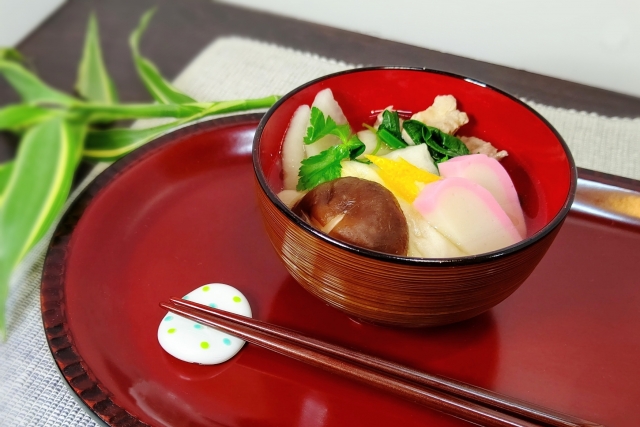How Japanese spend on New Years

あけましておめでとうございます Akemashite Omedetou Gozaimasu! means “Happy New Year.”
お正月 Oshogatsu (New Year) is a very important holiday for the Japanese. People return to their parents’ homes and spend time with family and relatives.
Like me, many of us live far away from our parents and siblings. Oshogatsu is an exciting opportunity for us to gather together and catch up with our families.
If you are interested in how Japanese spend on New Years Eve, please check this out too!

初日の出 – Hatsuhinode

Watching the very first sunrise on the 1st of January is considered a symbol of wishing for happiness throughout the year. This belief stems from the idea that a god will rise with the first sunrise. The tradition became popular around the Meiji Era, approximately 100 years ago. Today, watching the first sunrise is seen as a good omen!
A popular place to watch the sunrise is usually at the beach. I recall that my brother once rode his bike for 2 hours in the middle of the night just to witness the first sunrise. I’m certain it was a memorable experience for him and his friends.
年賀状 – New Years Card

Okay, I was surprised to find out that the price of New Year’s cards increased from 50 yen to 62 yen while I was living in Bangkok. When I was a child, I used to be so excited to check the mail on New Year’s Day to see who had sent me a New Year’s greeting card! We make New Year’s cards using an app, which can be a bit costly, but we’re happy to do it every year. We only send a few cards to relatives who send us cards each year.
Nowadays, it seems to be becoming more popular to send online “nengajo” or just a New Year’s message via LINE. While I prefer digital methods for most things, I personally love the “nengajo” culture and would like to keep this tradition alive!
おせち- Osechi

Osechi is a special traditional cuisine that we typically eat starting from the 1st of January and continue for three days. However, in some districts like the North-East or Hokkaido area, it is consumed on New Year’s Eve.
You might wonder why we eat Osechi for three days. It’s because we believe that using fire or a stove during the New Year is considered bad luck, as it might scare away the gods. Therefore, Osechi dishes are designed to be stored in the fridge.
お雑煮 Ozouni

Ozouni is another traditional New Year’s cuisine eaten alongside Osechi, symbolizing wishes for a bountiful harvest and safety throughout the year. Traditionally, we offer a 鏡餅 (kagamimochi) rice cake to the gods before the New Year because rice cakes are considered auspicious.
While Mochi, rice cake is a component of Ozoni, it’s very interesting that ingredients and soup flavor can vary widely based on each family’s traditions and regional districts. However, it’s worth noting that Okinawa doesn’t have an Osechi culture at all.
お年玉 – Otoshidama

Otoshidama is a New Year’s gift that originally originated from China. While it became popular to place money inside the envelope during the Meiji era, traditionally, people would give a mochi rice cake.
I come from a large family with three older siblings. As a result, during Oshogatsu, we couldn’t afford to give Otoshidama only to my son; we also gave it to my and Ray’s nephews and nieces. The children are always delighted to receive Otoshidama from parents, relatives, and grandparents.
As an additional note, when giving money to Japanese individuals, it’s preferable to place the money in an envelope. Handing money directly is considered rude in Japanese culture. If you don’t have an envelope, wrapping the money in white paper or even tissue is a suitable alternative.
初詣 – Hatsumoude

Hatsumode is the act of visiting a shrine or temple during the New Year’s holiday. People visit these places to express gratitude for the past year to either God or Buddha and to wish for a happy new year. When visiting a shrine or temple, it’s common for people to try an Omikuji (a fortune-telling paper) to see what the upcoming year might hold. Some individuals are thrilled to receive a 大吉/Daikichi (the luckiest) or 凶/Kyou (the unluckiest). After drawing a paper, they make a wish for a great year ahead and tie it up, as depicted by the little girl in the picture.
Since my family dislikes crowds, we usually visit the shrine at the end of January.
It’s important to note that if someone is in mourning, it’s considered inappropriate to participate in Hatsumode, as it is a joyous occasion. Similarly, it’s advisable not to send Nengajo in such circumstances.
福袋 – Fukubukuro Shopping

Fukubukuro is a lucky bag sold during the New Year. Stores pack a variety of items inside these bags, prices are more reasonable than during regular seasons, and they operate on a first-come, first-served basis. Consequently, people line up at department stores and then rush directly to their favorite shops to purchase them!
Opening a Fukubukuro is exhilarating because you can’t see what’s inside before buying it. It’s like opening a mystery bag! While it’s a delight to get exactly what you hoped for, some people might be disappointed.
Useful Japanese conversational sentences
Japanese conversation is very unique sometimes, and cannot translate in English perfectly. Yet, these below sentences are very common to say for New Years Greeting on written and spoken Japanese languages.



